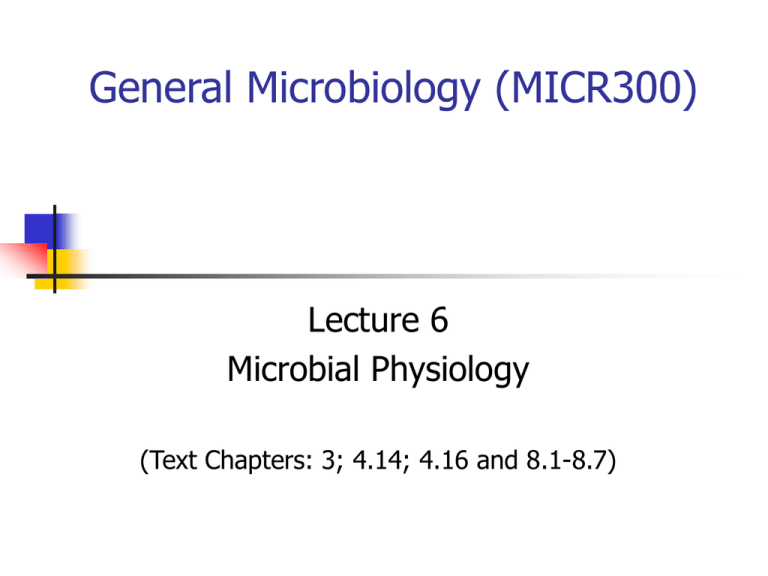Vectors for Even Larger Genomic DNA Inserts
advertisement

General Microbiology (MICR300) Lecture 6 Microbial Physiology (Text Chapters: 3; 4.14; 4.16 and 8.1-8.7) Flagella and Motility Flagella move the cell by rotation, much like the propeller in a motor boat (Figure 4.56). An appreciable speed of about 60 cell lengths/second can be achieved. Flagella are made up of the protein flagellin and can occur in a variety of locations and arrangements. Each arrangement is unique to a particular species. Flagella and Motility In polar flagellation, the flagella are attached at one or both ends of the cell. In peritrichous flagellation, the flagella are inserted at many locations around the cell surface (Figure 4.58). Chemotaxis Motile bacteria can respond to chemical and physical gradients in their environment. Chemotaxis (Figure 4.61) is the directed movement of organisms in response to chemicals. Chemotaxis (Continued) In chemotaxis, random movement of a prokaryotic cell can be biased either toward or away from a stimulus by controlling the degree to which runs or tumbles occur. The latter are controlled by the direction of rotation of the flagellum, which in turn is controlled by a network of sensory and response proteins. Counterclockwise rotation moves the cell in a direction called a run. Clockwise rotation causes the tuft of flagella to spread, resulting in tumbling of the cell. http://www.icbm.de/pmbio/mikrobiologisc her-garten/eng/enswi01.htm Attractants and Repellants Positive chemotaxis is occurring toward an attractant when the sum of bacterial runs, or movement from flagella rotation, results in net movement in the direction of increasing concentration of a chemical. In contrast, motile bacteria will move away from a repellant (Figure 4.62). Q: which beaker contains a capillary tube filled with repellent? Metabolic Regulation There are two major levels of regulation in the cell. One controls the activity of preexisting enzymes. One controls the amount of an enzyme produced. Regulation of Enzyme Activity Enzyme activity can be controlled via: Noncovalent Enzyme Inhibition, or Covalent Modification of Enzymes. Noncovalent Enzyme Inhibition Many metabolic reactions can be regulated through control of the activities of the enzymes that catalyze them. An important type of regulation of enzyme activity is feedback inhibition (Figure 8.2), in which the final product of a biosynthetic pathway inhibits the first enzyme unique to that pathway. Allosteric Enzyme An allosteric enzyme has two binding sites, the active site, where the substrate binds, and the allosteric site, where the inhibitor (called an effector) binds reversibly (Figure 8.3). Isoenzymes Some biosynthetic pathways under feedback inhibition employ isoenzymes, different proteins that catalyze the same reaction but are subject to different regulatory controls (Figure 8.5). Covalent Modification of Enzymes Covalent modification is a regulatory mechanism for changing the activity of an enzyme. Enzymes regulated in this way can be reversibly modified. One type of modification is adenylylation (the addition of AMP) (Figure 8.6). Gene Expression Regulation The amount of enzyme produced can be controlled at the transcription level - gene expression. This can be either positive control or negative control Negative Control of Transcription: Repression and Induction Negative control involves prevention of transcription by regulatory proteins called repressors. The amount of an enzyme in the cell can be controlled by decreasing (repression, Figures 8.11, 8.13) or increasing (induction, Figure 8.12) the amount of mRNA that encodes the enzyme. Positive Control of Transcription Positive control of transcription is implemented by regulators called activator proteins. They bind to activator-binding sites on the DNA and stimulate transcription. As in repressors, activator protein activity is modified by effectors. For positive control of enzyme induction, the effector promotes the binding of the activator protein and thus stimulates transcription (Figures 8.14, 8.15).


